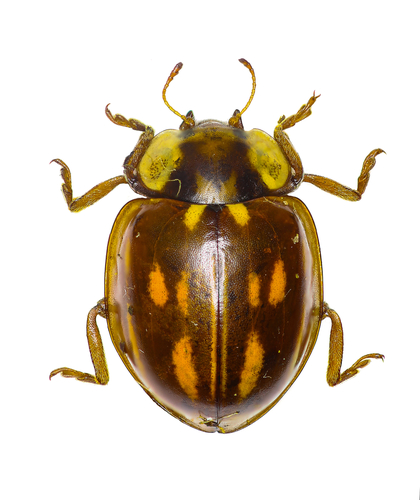Common Name: Drugstore Beetle
Scientific Name: Stegobium paniceum (Linnaeus)
Class/Order/Family: Insecta/Coleoptera/Anobiidae
Metamorphosis: Complete
Introduction
The drugstore beetle apparently got its common name because of its being a serious pest of stored herbs used as medicine in early apothecaries or drug stores. Its distribution is  worldwide. RECOGNITION. Adults about 1/16-1/8″ (2-3.5 mm) long. Color reddish brown to brown. Antennae clubbed, club of 3 elongated and broadened segments. Punctures or pits on elytra (wing covers) arranged in longitudinal rows.
worldwide. RECOGNITION. Adults about 1/16-1/8″ (2-3.5 mm) long. Color reddish brown to brown. Antennae clubbed, club of 3 elongated and broadened segments. Punctures or pits on elytra (wing covers) arranged in longitudinal rows.
As typical of anobiid, head and prothorax bent downward, making head barely or not visible form above and giving beetle a strongly humped appearance. Mature larva about 1/16-1/8″ (2-3 mm) long. Form C-shaped, with thoracic and abdominal segments about same width. Color white, with many short hairs. With well-developed 4 segmented legs. Cigarette beetle larvae have the same description.
Recognition
Adults about 1/16-1/8″ (2-3.5 mm) long. Color reddish brown to brown. Antennae clubbed, club of 3 elongated and broadened segments. Punctures or pits on elytra (wing covers) arranged in longitudinal rows. As typical of anobiid, head and prothorax bent downward, making head barely or not visible form above and giving beetle a strongly humped appearance. Mature larva about 1/16-1/8″ (2-3 mm) long.
Form C-shaped, with thoracic and abdominal segments about same width. Color white, with many short hairs. With well-developed 4 segmented legs. Cigarette beetle larvae have the same description.
Similar Groups
(1) Cigarette beetle (Lasioderma serricorne) with serrate/sawlike antennae, elytral punctures scattered in distribution, not in rows.
(2) Anobiid powderpost beetles (Anobiidae) are not associated with stored food products.
(3) Dermestid beetles (Dermestidae) have short antennae with symmetrical club. (5) Bostrichid powderpost beetles (Bostrichidae) have short antennae, with compact club.
Biology
The female drugstore beetle lays her oval, whitish eggs in and about the food materials. They hatch in a few days, and there are 4-6 larval instars which require 4-5 months for development. The full-grown larva pupates in a silken cocoon with bits of foodstuff incorporated into it, and pupation last 12-18 days. The complete life cycle (egg to egg) usually requires 7 months (range 60-210 days), but there may be 1-4 generations per year depending on the temperature.
Control
The drugstore beetle attacks a host of items that include any household food and spice, as well as such things as drugs, hair, horn, leather, and museum specimens. Most commonly attacked are bread, flour, meal, breakfast foods, and condiments such as red pepper. It is also a pest of books and manuscripts. Adults can fly and they are attracted to light.